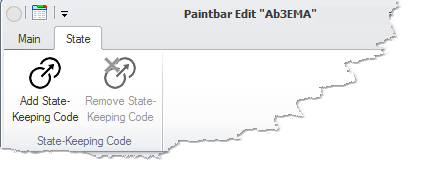Advanced - State Keeping
Paintbar as a State Machine |
The paintbars (and indicators in general) are, internally, state machines. What that means in abstract is that there is a saved "state", the paintbar or indicator calculation is performed based on that state and the candle that is passed to the calculation, then a new state is generated (that includes the output of the paintbar or indicator).
For simple paintbars, that state machinery is hidden, because it is implicit. The SetColor etc. functions set the current state, and the Open, Close, etc. indexed variables as well as Indicator Variables are passed in as part of the current state.

If you want to do something more complex, the state machinery needs to be explicit. The Advanced Paintbar Editor will add the state-keeping functions in for you - that functionality is in the ribbon menu's State tab.
State-keeping Internals |
There are several parts to the state-keeping in the paintbars:
1. The State - it consists of
•PaintbarState struct that can contain any number of value types. It is very important that only value types are included in that struct, not reference types. There are two instances of the struct - CurrentState and SavedState. All the calculation should be performed using the CurrentState, the SavedState is only there for state-keeping.
•For any objects/classes that you need for the state (that is, reference types), you have to do the state-keeping yourself. That would include defining the current/saved copy of the object and the deep-copying between them in the state-saving and state-restoring functions. We provide a very useful class FIFOQueue that would probably be sufficient for most of your needs. |
2. The initialization functions PaintbarInitialize and PaintbarClearState.
•PaintbarClearState is only executed at the start of the calculation (that is, before the first candle of the chart is passed to the MainCalculation function), and should be used to initialize the state variables.
•PaintbarInitialize is also executed at the start of the calculation and should include any other initializations required. |
3. The state-keeping functions PaintbarSaveState and PaintbarRestoreState.
•By default, when Advanced Paintbar Editor creates these functions in your code, they just copy CurrentState to SavedState and vice versa. If you have any other state-keeping variables, their copying should be inside these two functions as well. |
Example with Standard State-Keeping |
Let's say you want to create a paintbar that takes a 10-period EMA of the EMA that's on the chart, and shows positive color if close is above that line and negative if it is below. Here is the code that would do it (assume that the variable EMA_Line is the Pre-Defined Indicator Variable for the chart's EMA indicator.
double fEMAMult; // EMA Multiplier
/// <summary> |
Example with StateFIFOQueue State-Keeping |
Let's re-do the above example, with the only difference is that instead of 10-period EMA, we will do a 10-period SMA. We will use the StateFIFOQueue class to keep and calculate the SMA.
StateFIFOQueue NowSMA; |
